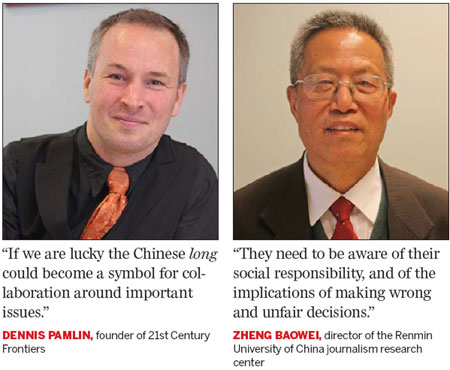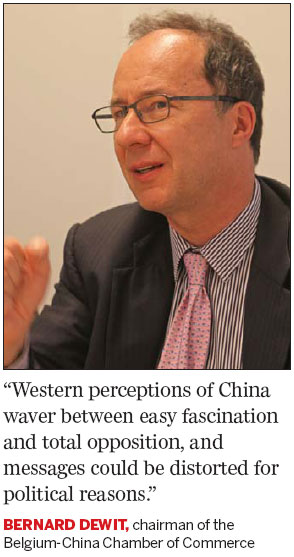Media study throws light on dark images of China
Updated: 2012-04-20 10:50
By Fu Jing (China Daily)
|
|||||||||||
Western media routinely portray China as hostile to dialogue even though the country has been on a path of opening up for more than 30 years, a study has found.
The conclusion, from the Research Center of Journalism and Social Development of Renmin University of China and 21st Century Frontiers, based in Sweden, are presented in a report on China's global image in Western media.
 |
"The findings conflict with the reality," says Dennis Pamlin, founder of 21st Century Frontiers, as the report was unveiled in Brussels on April 18. "And it indicates that both China and the rest of the world have homework to do to improve dialogue."
The two organizations began the project at the beginning of this year and focused on analyzing the covers of 100 news magazines that featured China over the past 15 years.
The magazines included The Economist of Britain, Time and Newsweek of the US and Der Spiegel of Germany. Twenty Chinese researchers analyzed what messages the magazines' editors had delivered by using the covers, many of which use the Chinese flag, a dragon and portraits of the late leader Mao Zedong.
 |
"We used the key word dialogue to describe the message in the magazine covers," says Zheng Baowei, director of the Renmin University of China journalism research center.
Five categories - hostile, not open to dialogue, neutral, open to dialogue and very open to dialogue - were set to assess the messages from the 100 covers.
"The findings really surprised me," Zheng says.
Of the 100 covers, the researchers say, 60 portray China in a negative light, either as hostile (44 covers) or not open to dialogue (16). Nineteen portray China as neutral and 16 as open to dialogue. Only five covers portray China as very open to dialogue.
The analysis also found that China is marginally more frequently presented in a non-human way (55 covers), the three most common symbols used to denote China being the national flag, a dragon and Mao.
They also found that editors wanting to portray China as friendly used a human face, 21 times out of 22. But when hostility was being depicted, a non-human image such as a dragon, flag or tank was used in 45 out of 61 cases.
Pamlin said it is necessary to differentiate between the Western dragon and the Chinese one, long. "This is the year of the dragon, and there is a unique opportunity to explore the possibility to help more people distinguish between the Western, fire breathing and destructive dragon and the Chinese long.
"The Chinese dragon ... brings luck, and as we need dialogue maybe if we are lucky the long could become a symbol for collaboration around important issues."
Professor Zheng expressed concern about the way newsrooms in the West depicted China, particularly as people everywhere were eager to be given a true picture of the country. "Most of these covers can only deepen the misunderstanding between China and the rest of the world."
Pamlin and Zheng, the research leaders, say that in publishing the findings they aimed to inspire more dialogue everywhere. They particularly want to encourage editors to become aware of what message they will deliver when they make decisions related to content.
"They need to be aware of their social responsibility, and of the implications of making wrong and unfair decisions," Zheng says.
The research team says a program could be set up in which journalism and media students from China and other countries do a work exchange to promote communication between those in the media.
International meetings for journalists could also spend more time discussing how emerging countries such as China are portrayed and how dialogue can be encouraged, they say.
Advocating positive dialogue is the key, they say. "There is a tendency to focus more on problems and conflict than opportunities and dialogue in many cases."
To encourage the publication of items, including illustrations, that portray dialogue and collaboration, a global competition could be initiated by those in the media, they say. Of particular interest would be to show that dialogue is possible even when - indeed particularly when - there is significant disagreement.
Alex Kirby, a retired BBC journalist, said at the report launch that the findings are interesting and that there should be solutions to improve understanding.
Chinese journalists and editors could be invited to work in the newsrooms of Western media, as China Daily, which employs foreign reporters, editors and designers, has done, he said, and journalist associations in China and elsewhere should set up projects to increase understanding.
Cao Qing, a professor from Liverpool John Moores University, says that in follow-up research more attention should be paid to differentiating the audience/readership of the chosen media.
"Audience could be a new variable to the research, which would help better define the interactions between the given image and different social groups."
Measuring the impact of an image on an audience is important, he says, but difficult. Perceptions are bound to be influenced by things such as advertising, the domestic situation of each country and political influences.
Bernard Dewit, chairman of the Belgium-China Chamber of Commerce, says he feels most of the magazines chosen for the research are elite publications. "(Such publications), in my view, represent only a small percentage of the population."
It is also important to look at local and regional media, he says.
Western perceptions of China waver between easy fascination and total opposition, he says, and messages could be distorted for political reasons.
"It is also important to ... note ... that the audience of media is not a coherent bloc."
For example, business people have widely divergent perceptions of China, he says.
Multinationals with a foothold in China view the country very positively, he says, but many small- and medium-sized enterprises pick up what they know of the country through superficial general publications and media and are frightened by it.
Contact the writer at fujing@chinadaily.com.cn
Today's Top News
Rescuers race against time for quake victims
Telecom workers restore links
Coal mine blast kills 18 in Jilin
Intl scholarship puts China on the map
More bird flu patients discharged
Gold loses sheen, but still a safe bet
US 'turns blind eye to human rights'
Telecom workers restore links
Hot Topics
Lunar probe , China growth forecasts, Emission rules get tougher, China seen through 'colored lens', International board,
Editor's Picks

|

|

|

|

|

|





